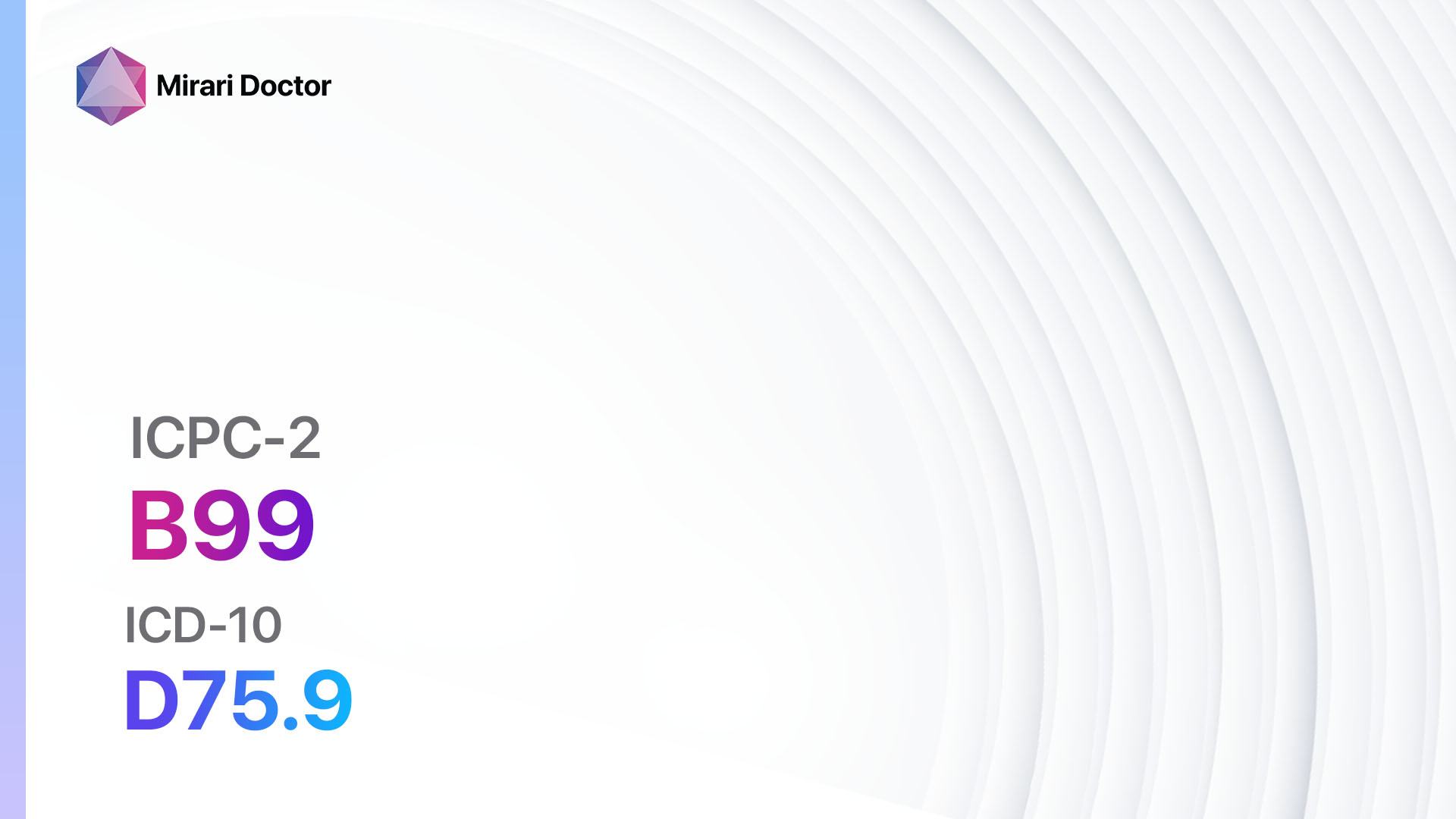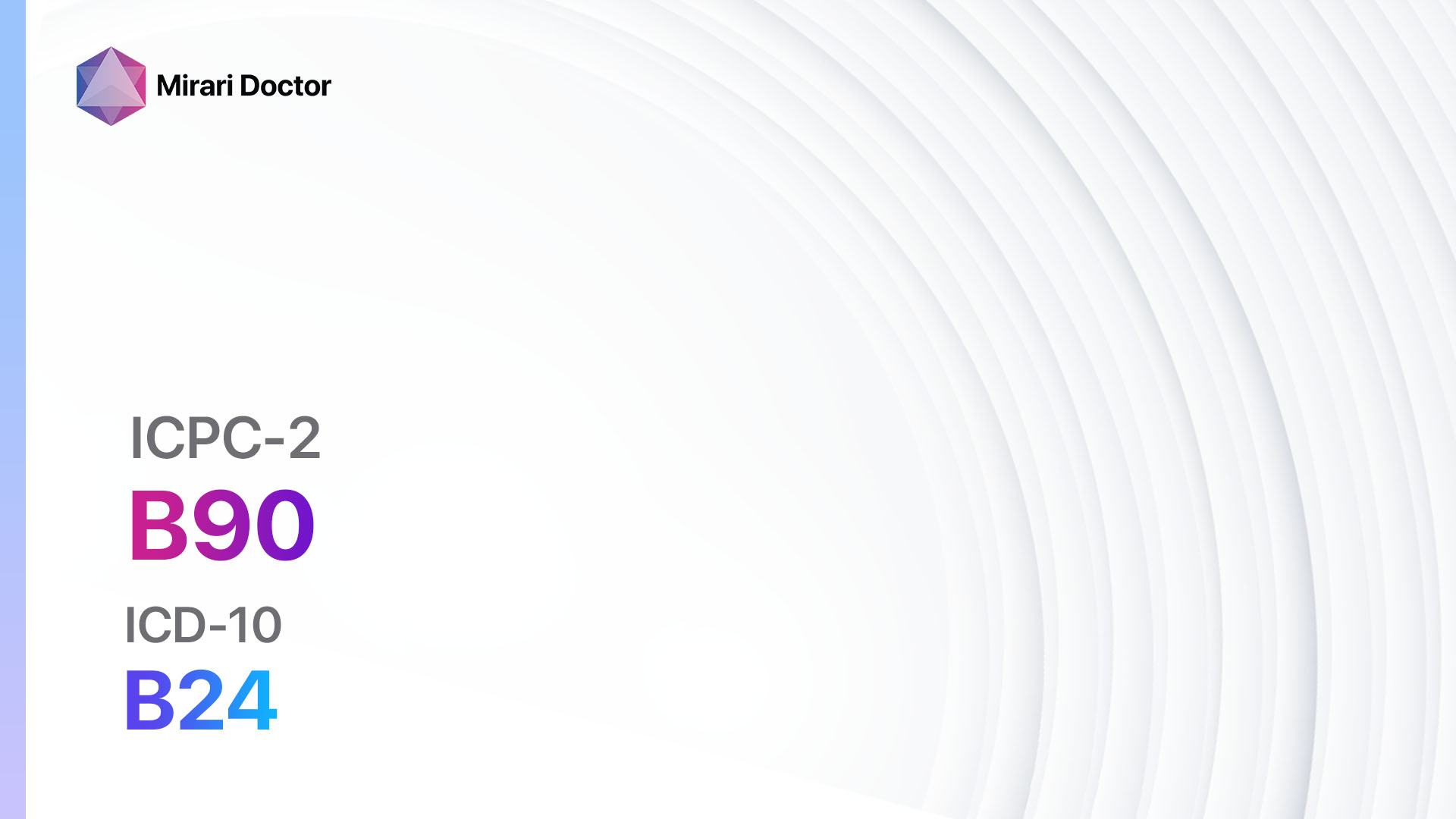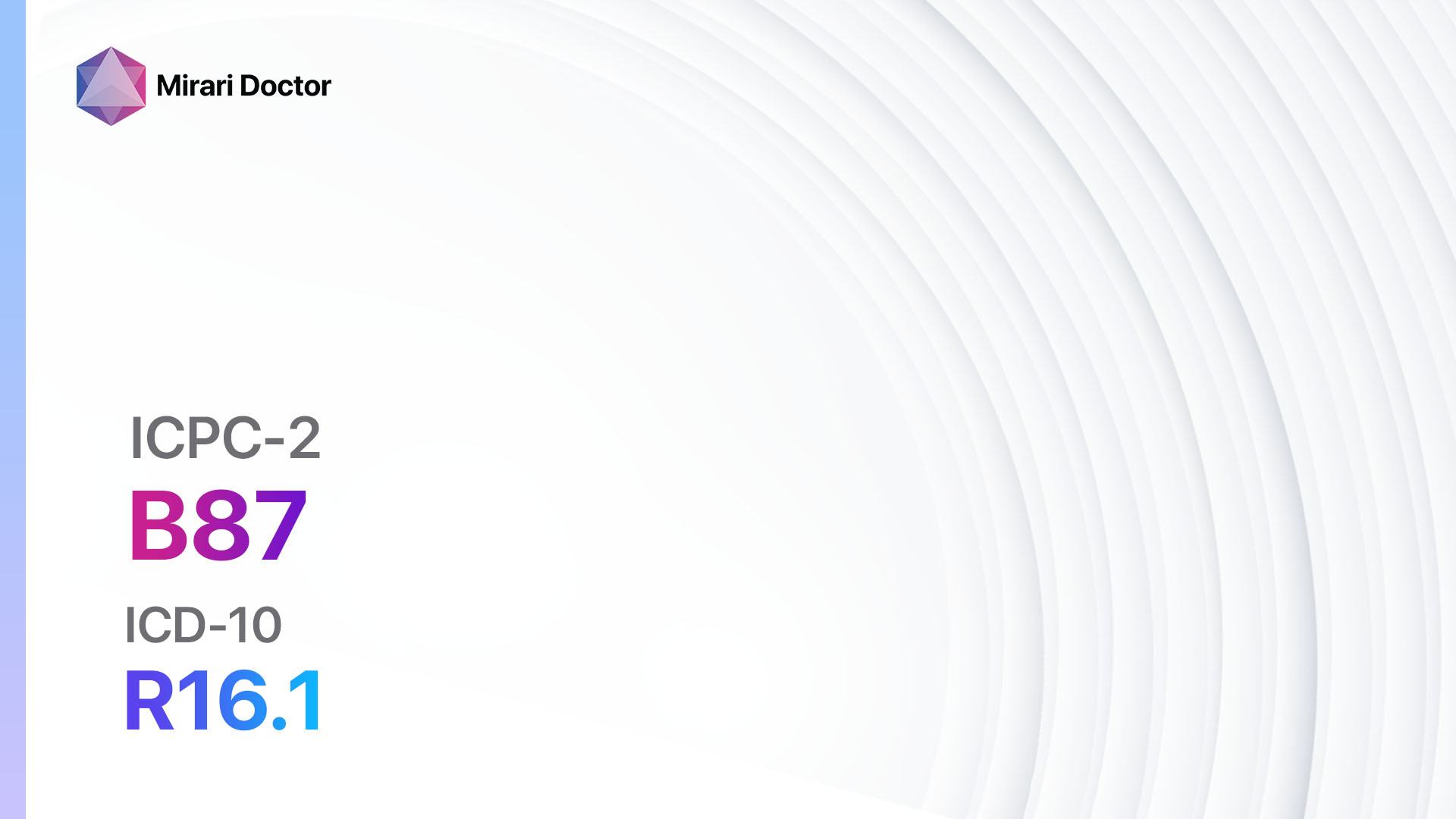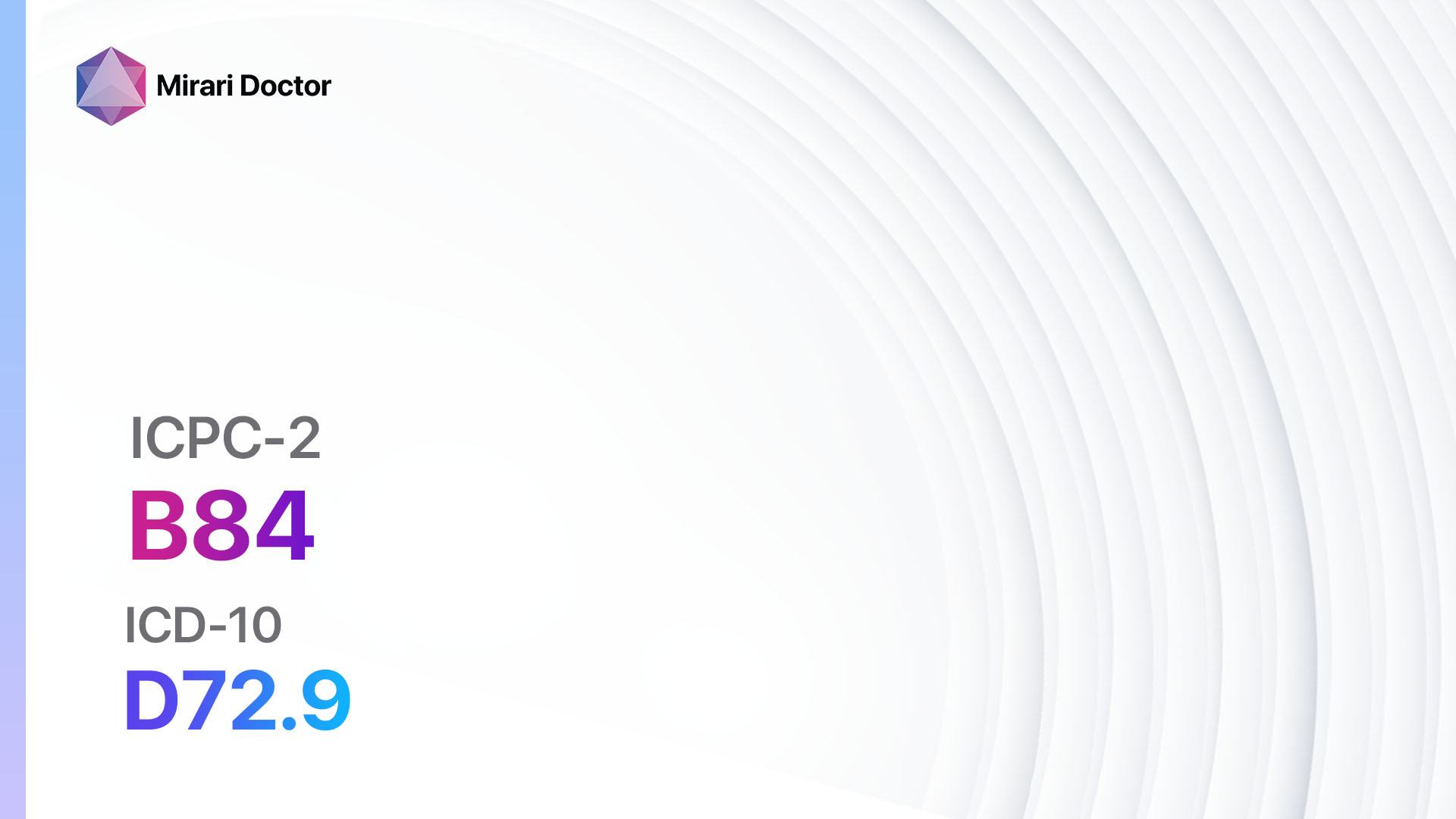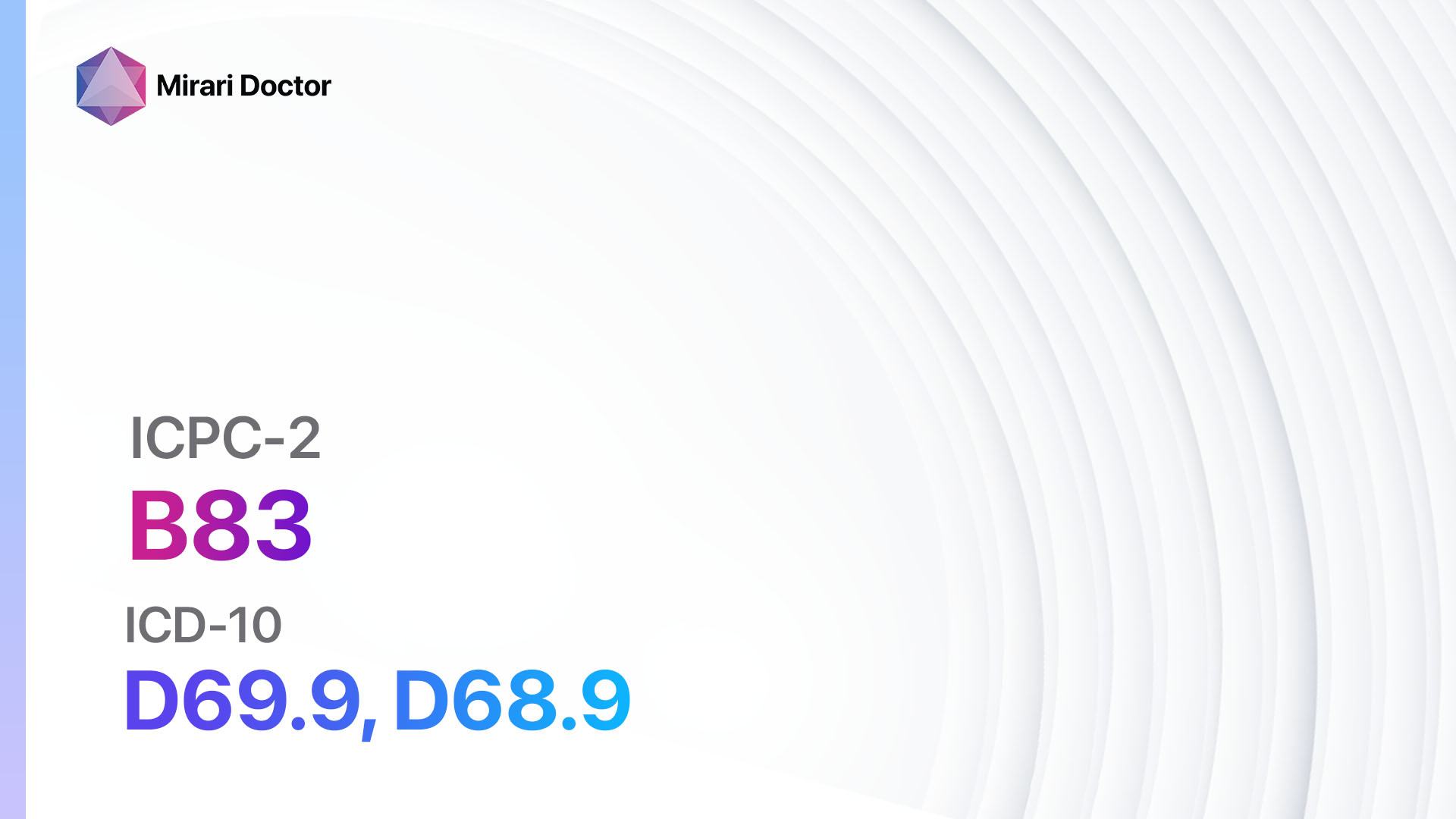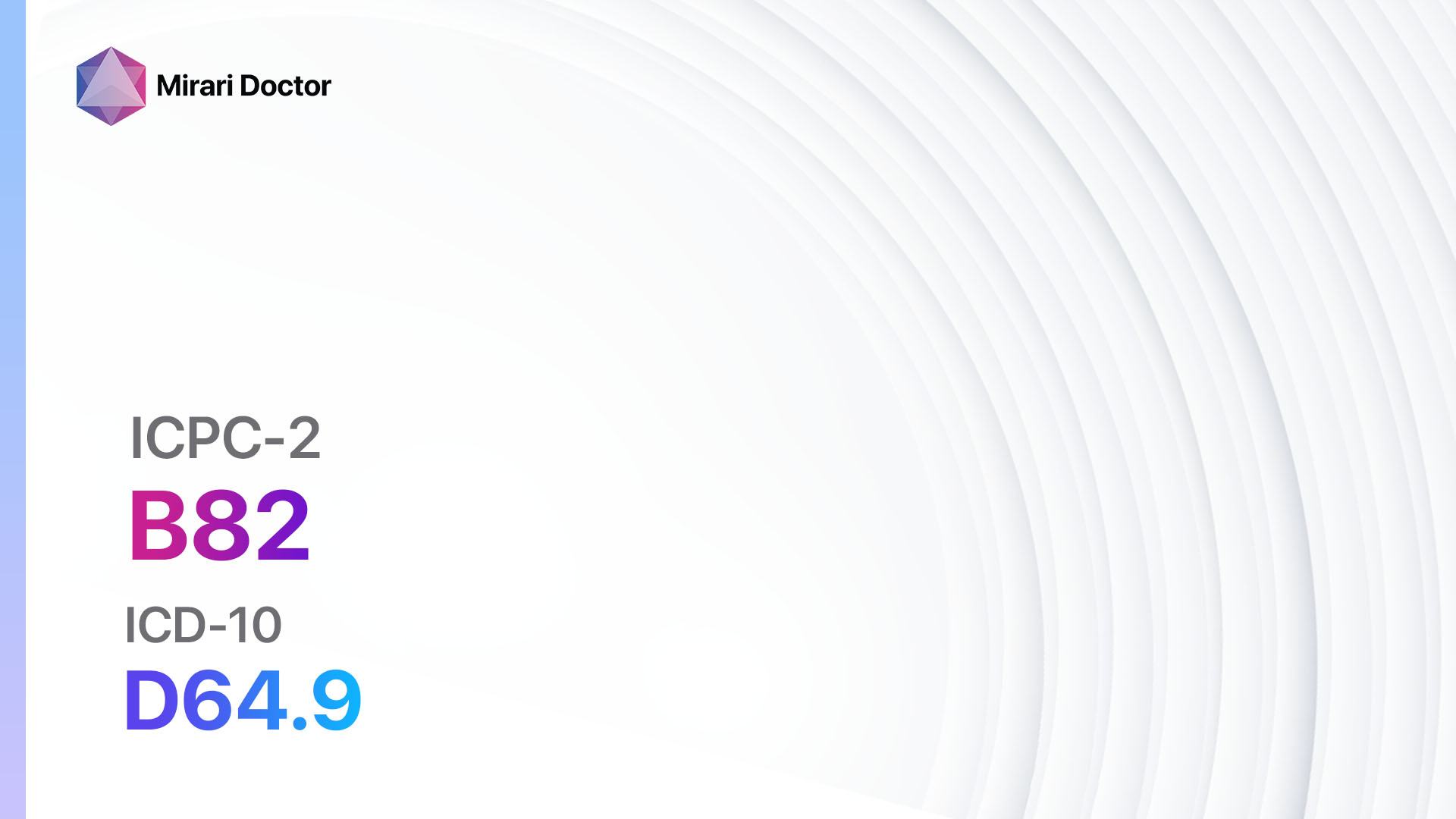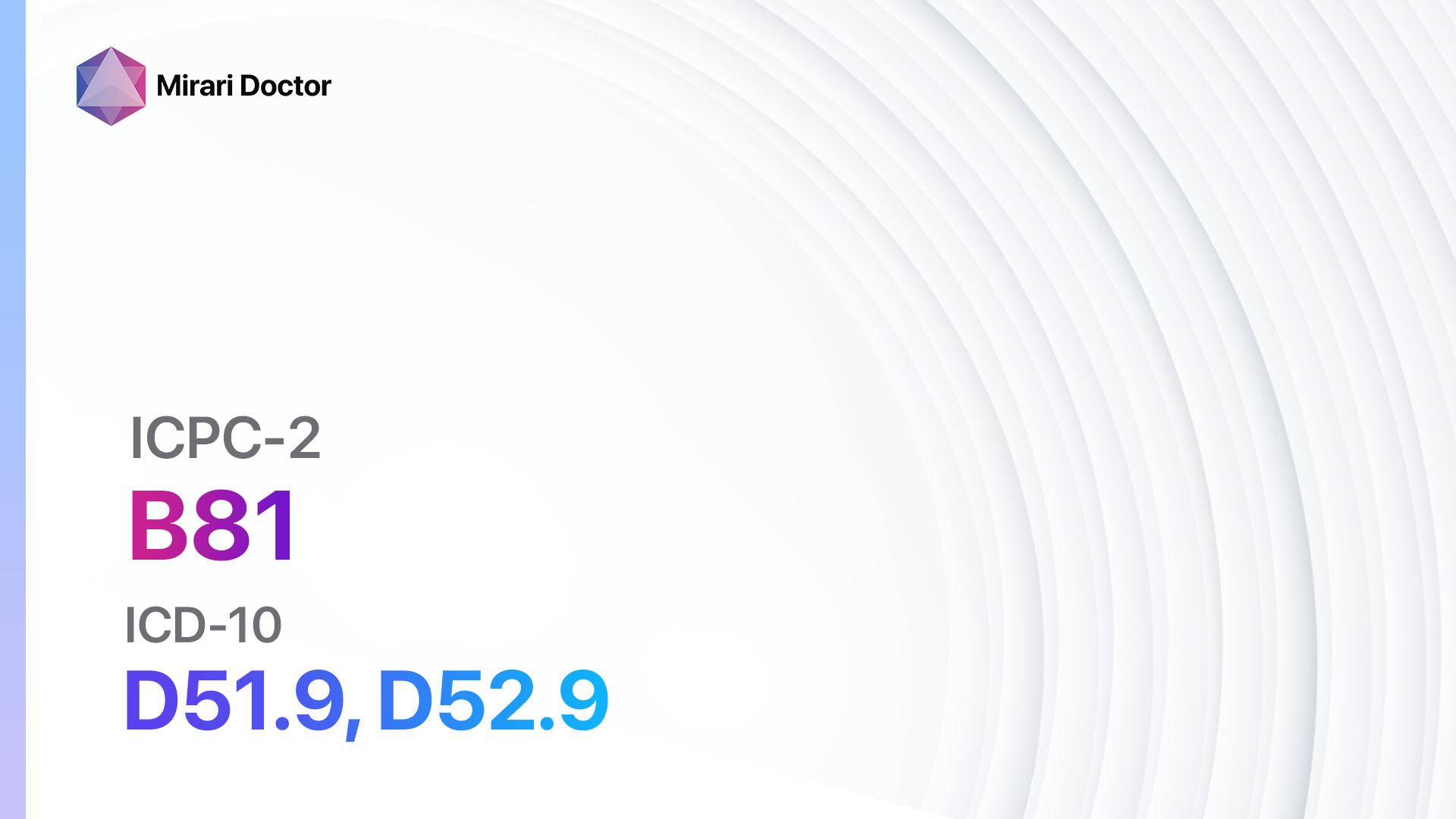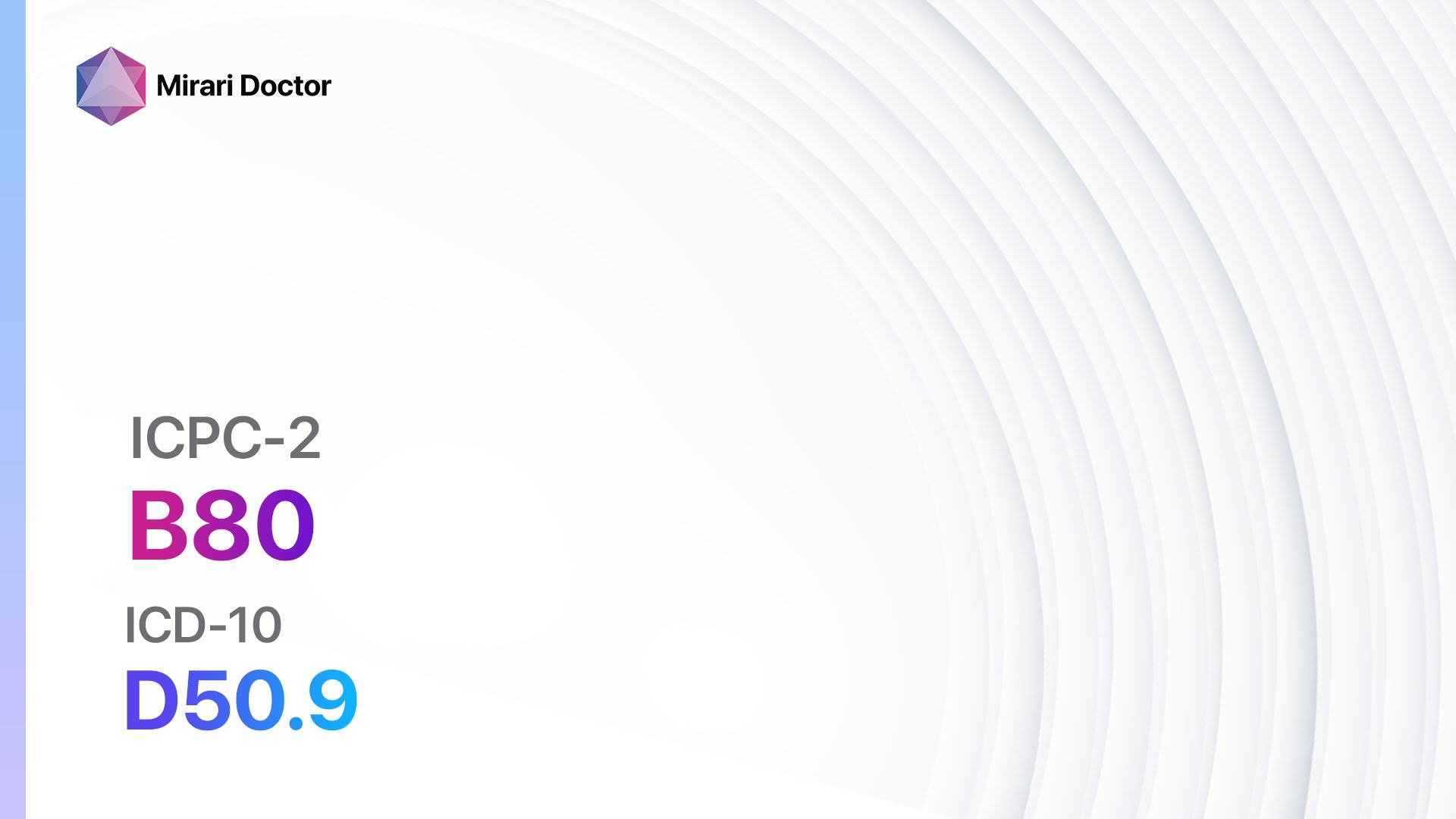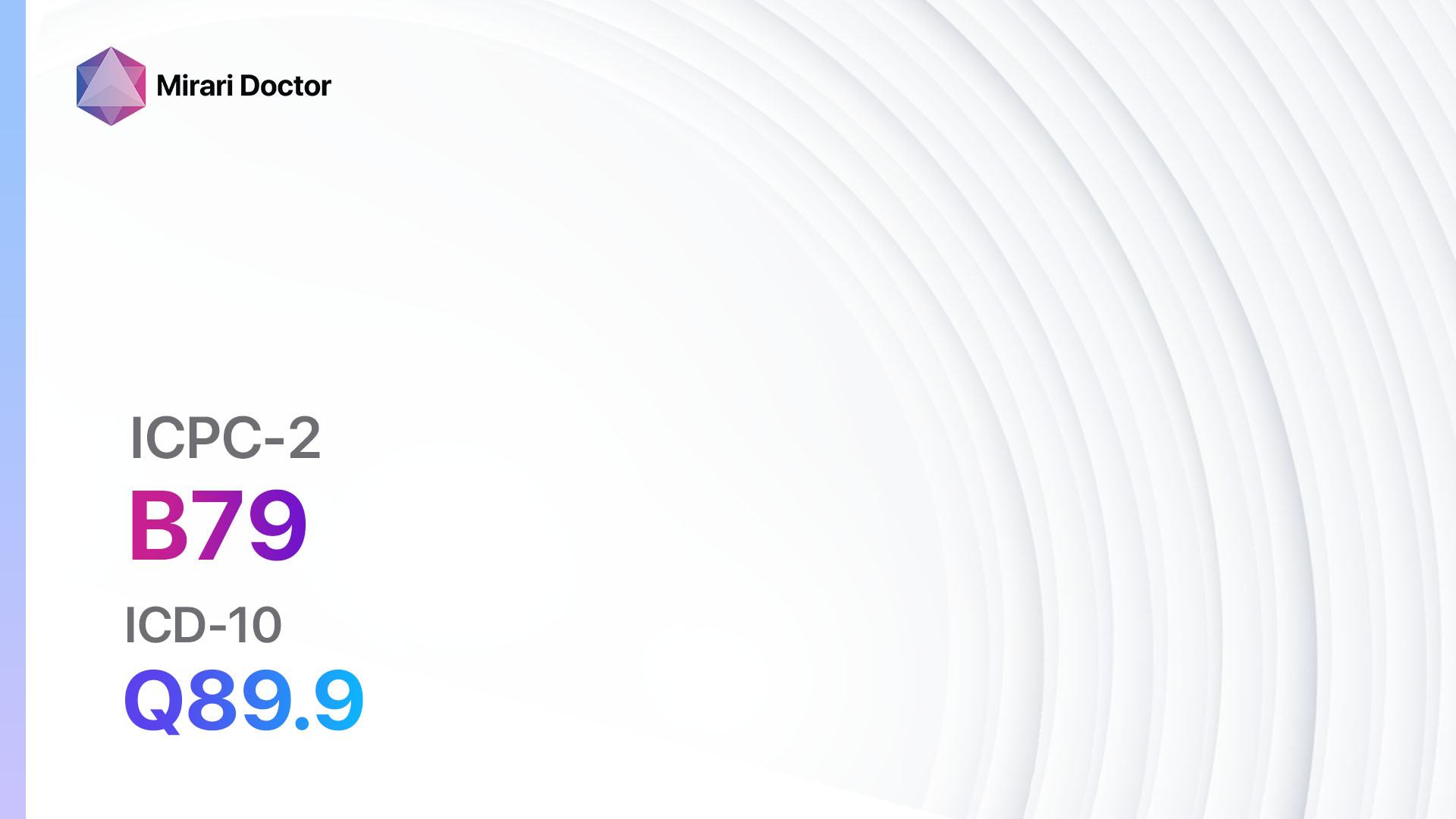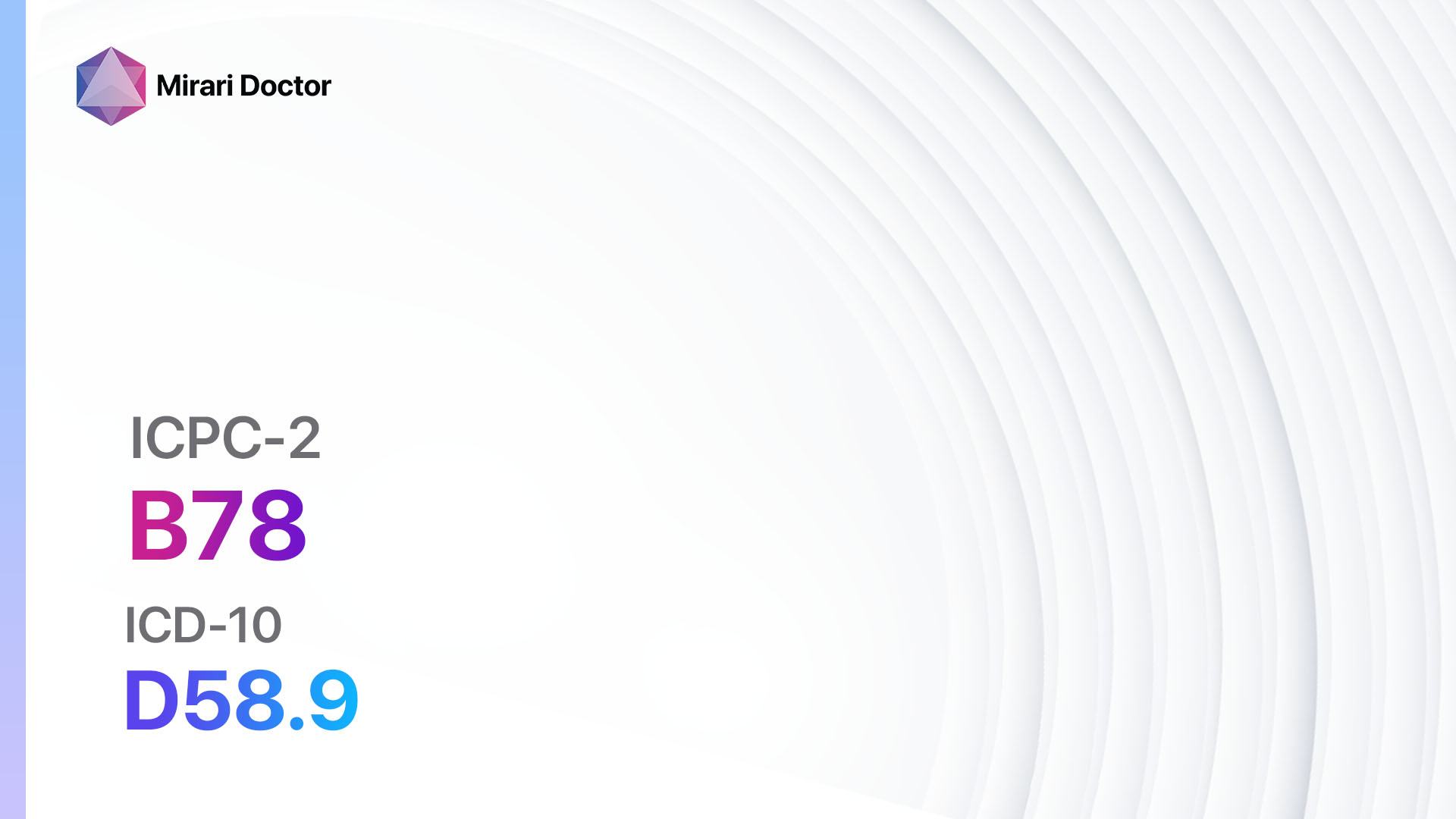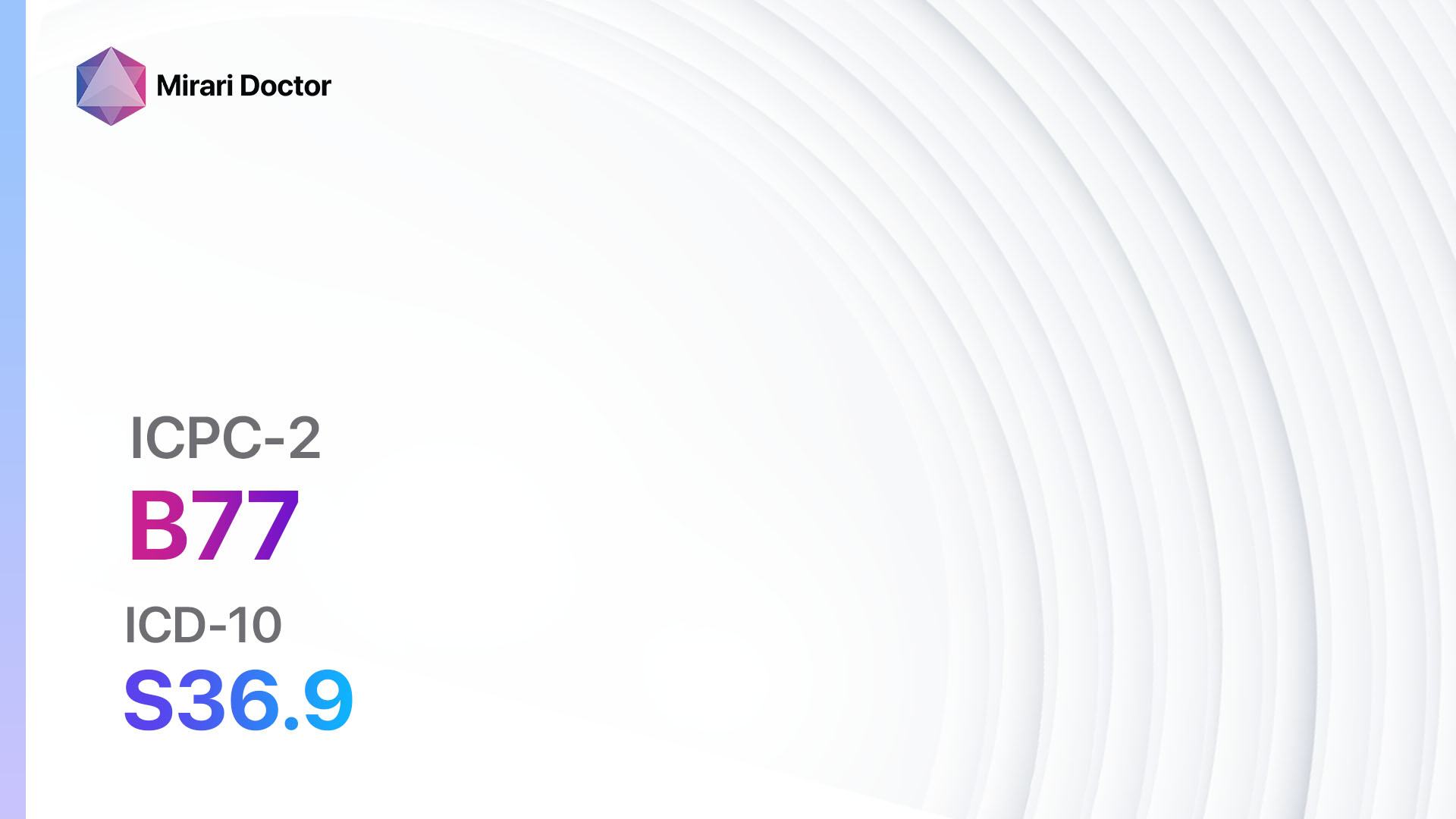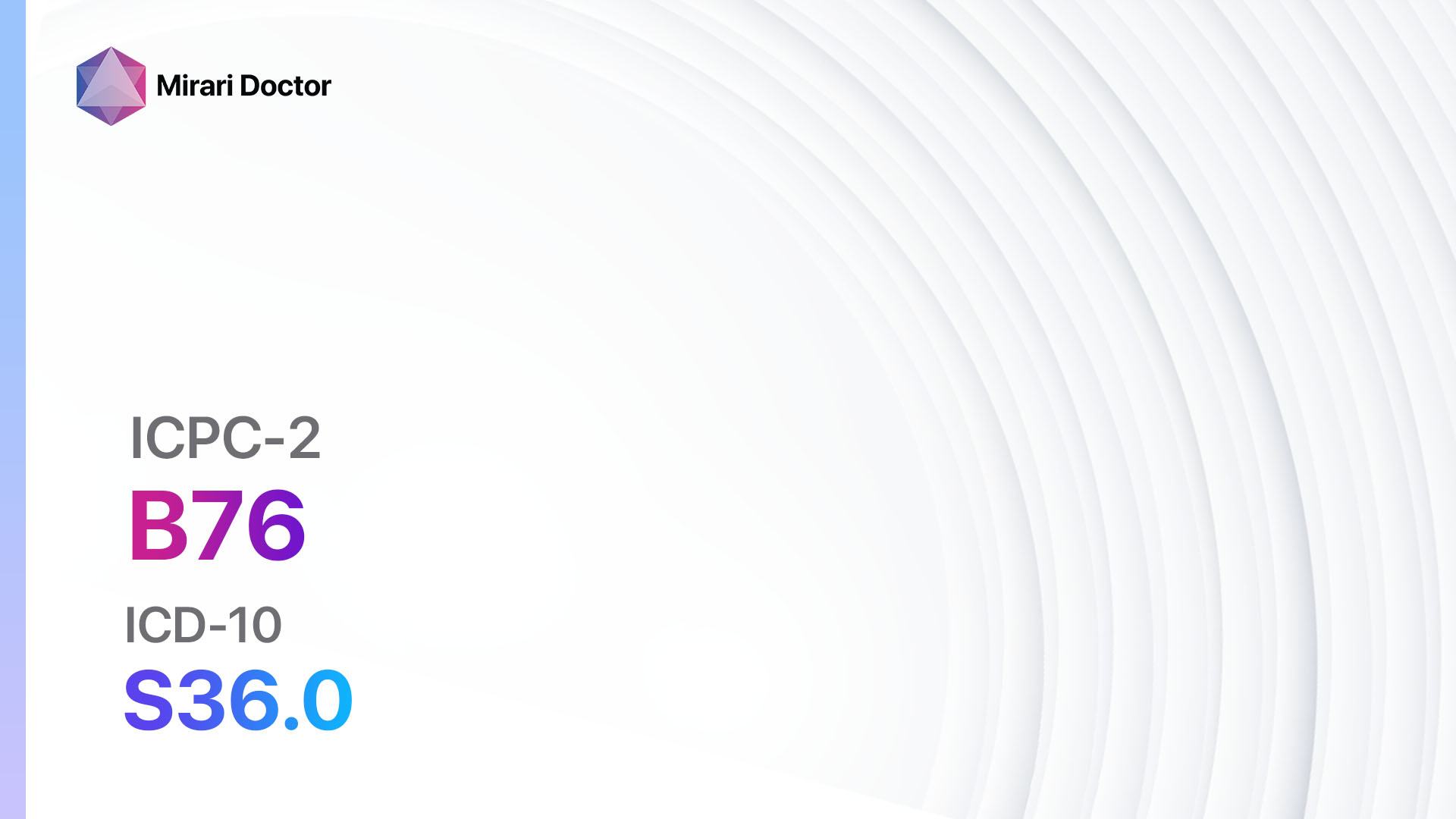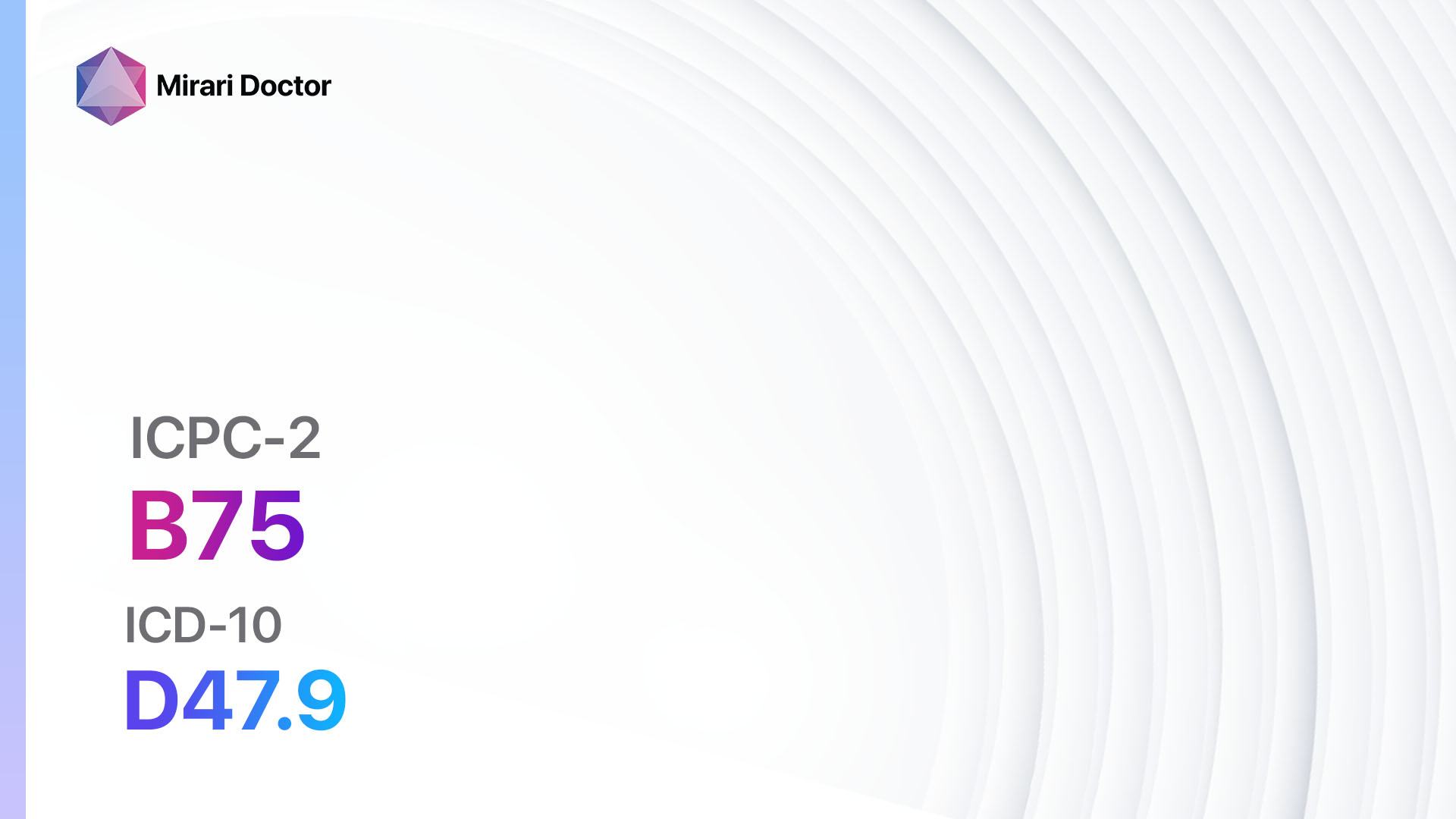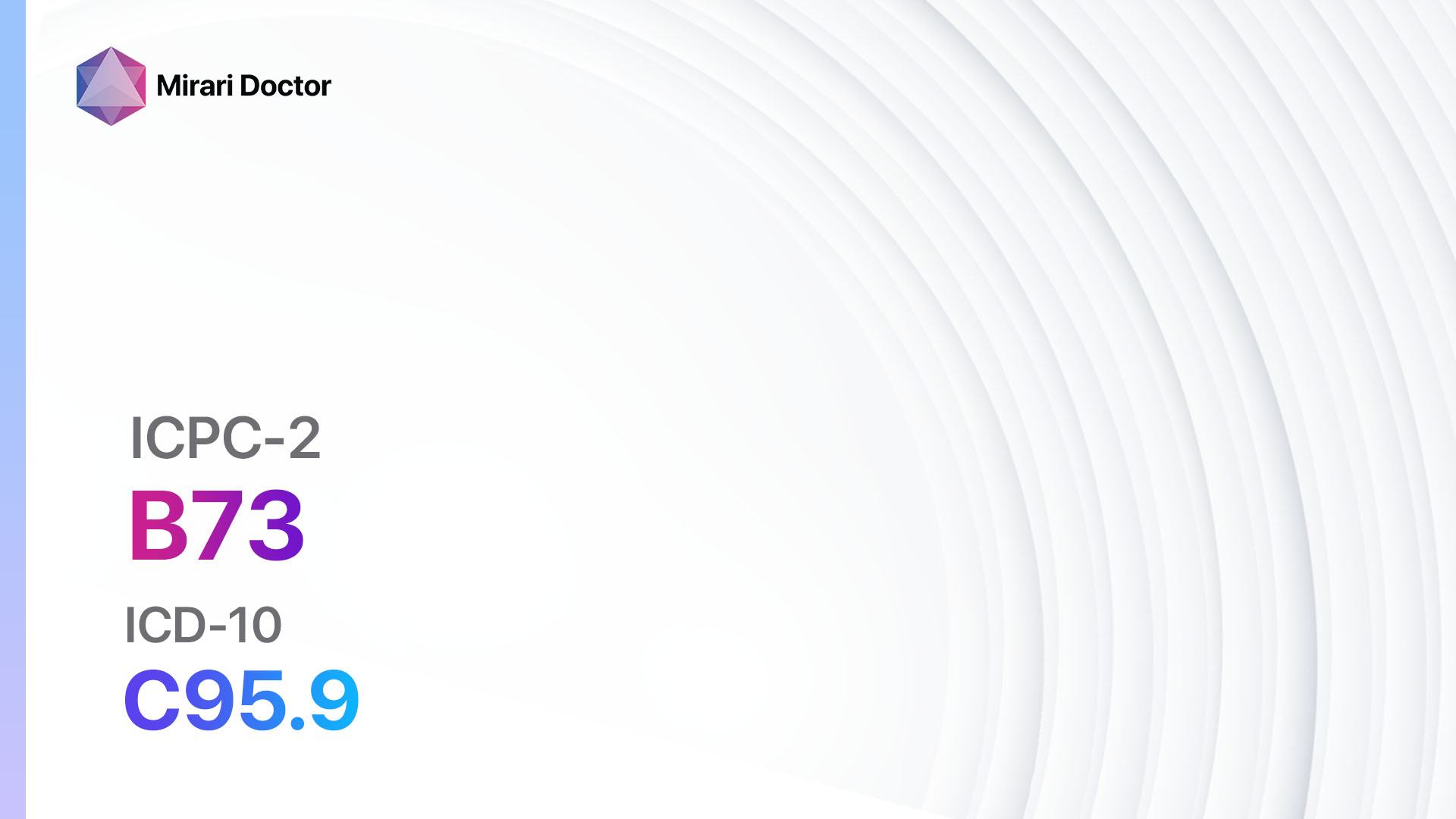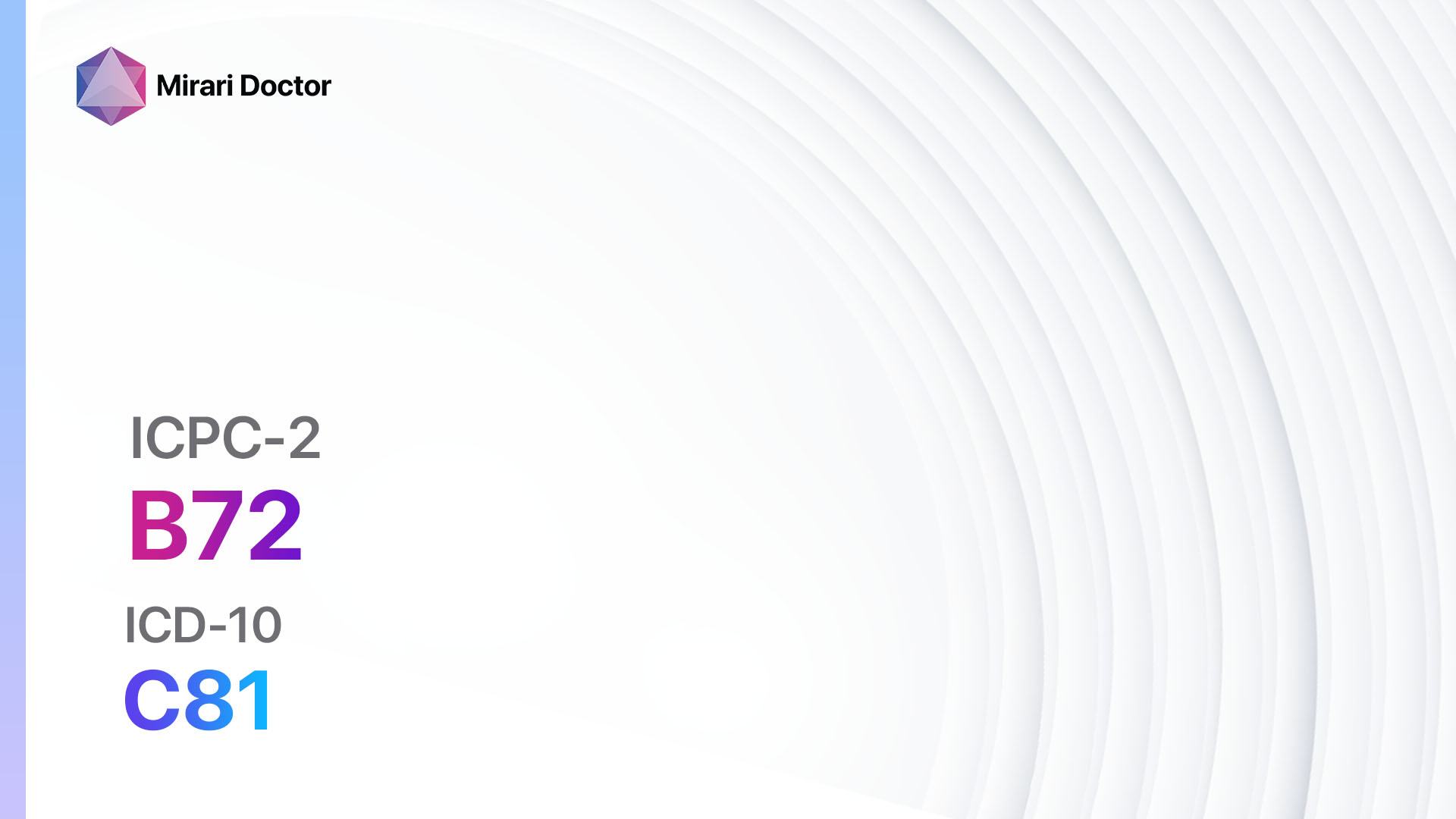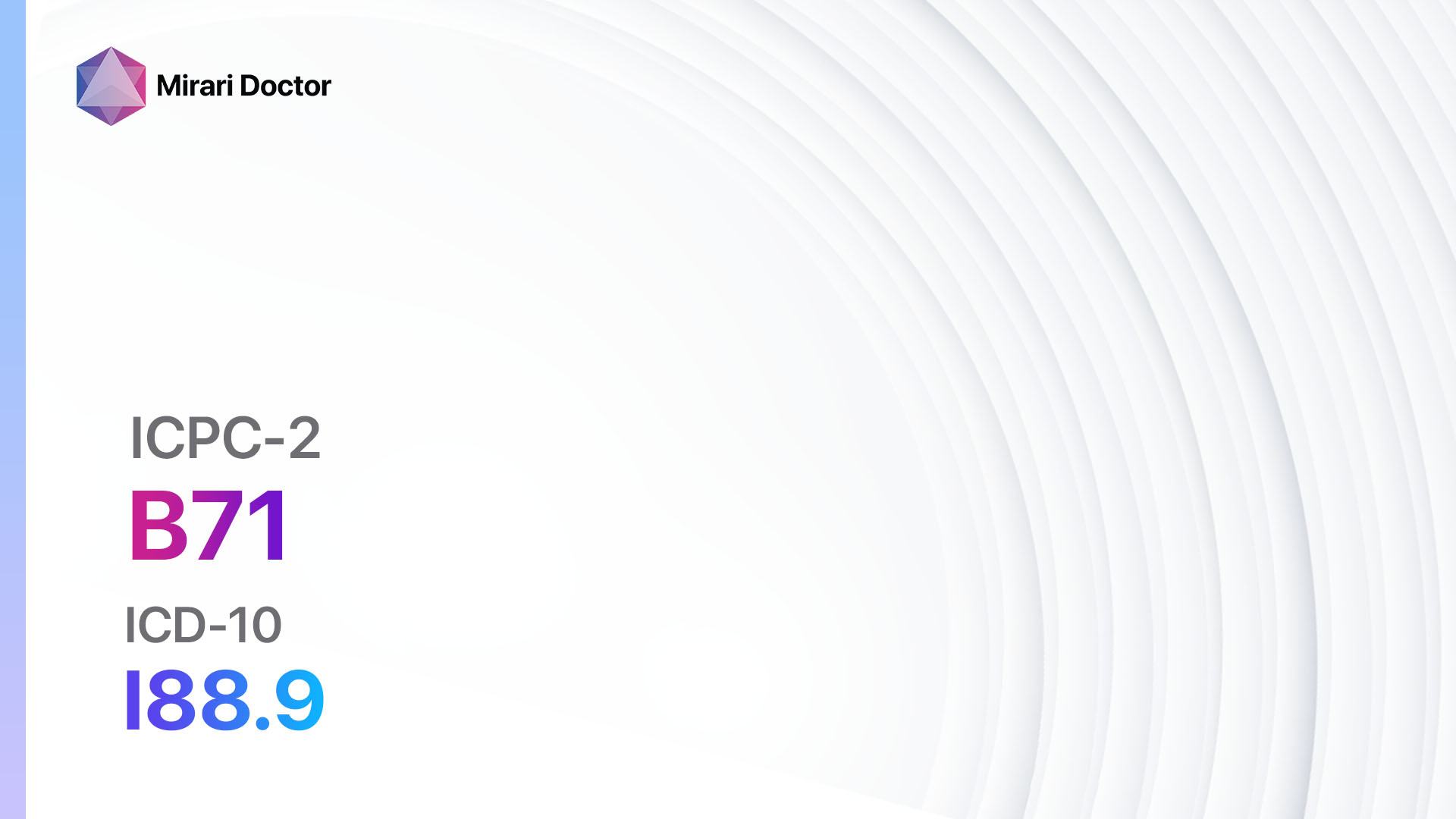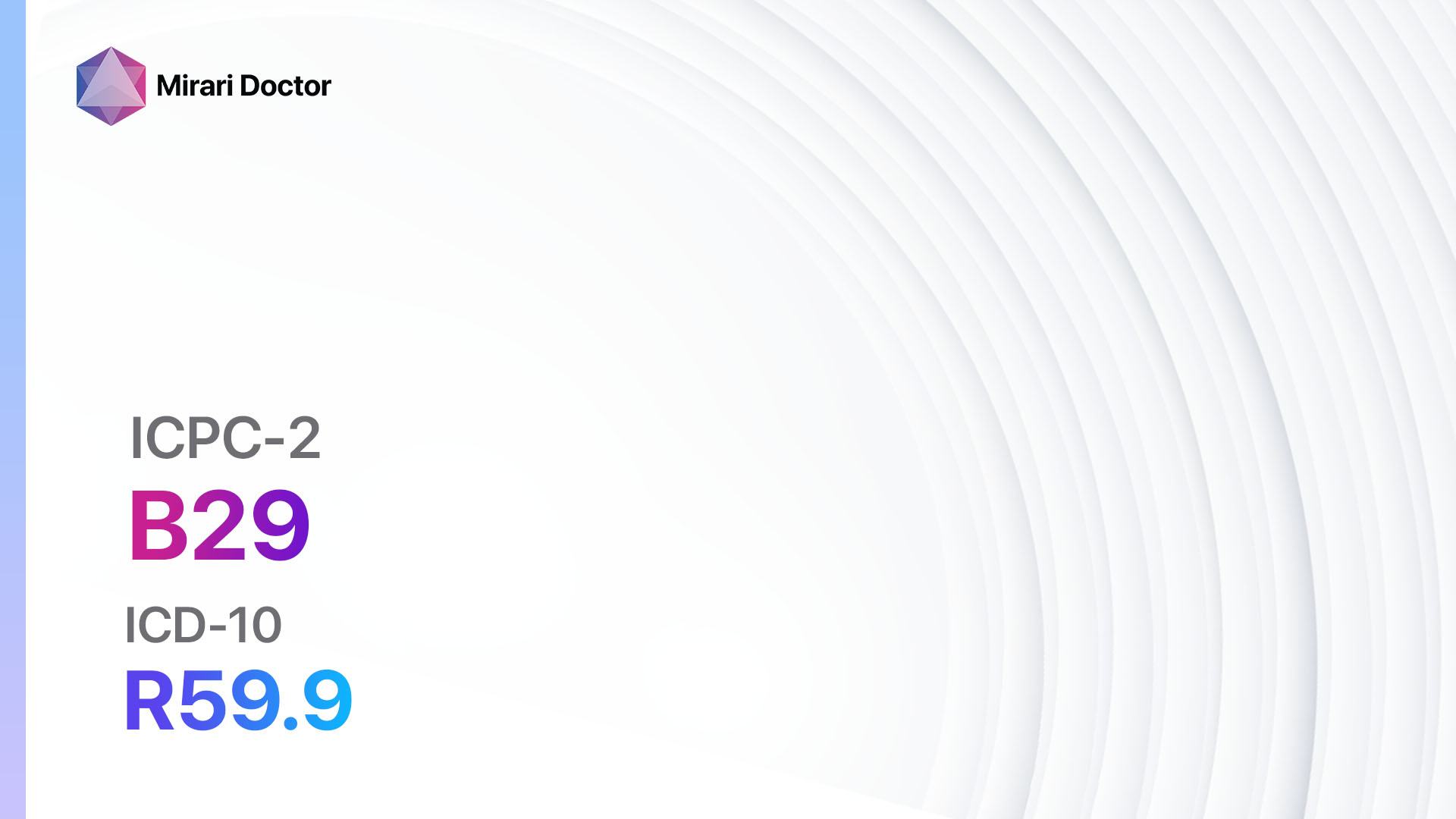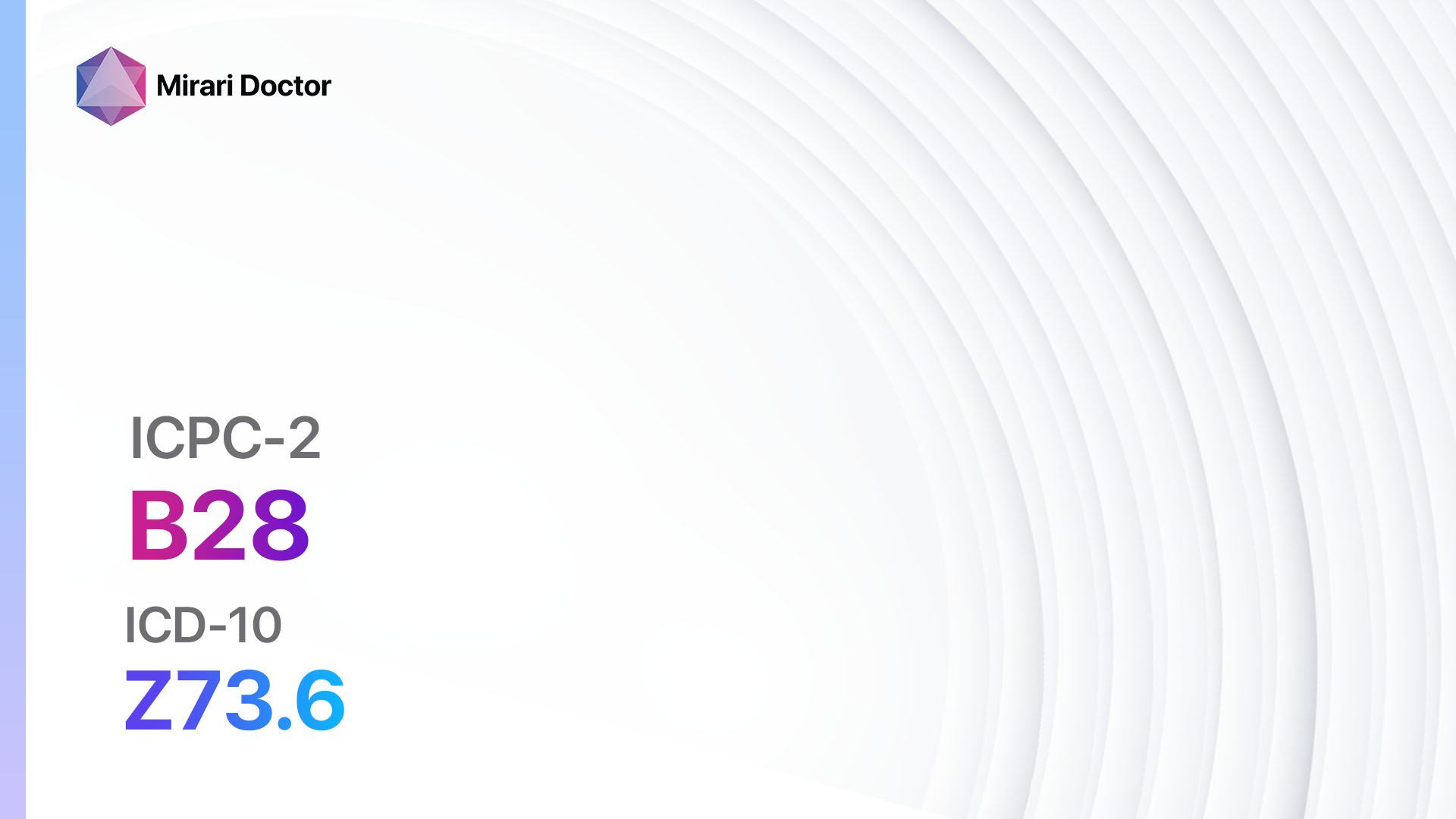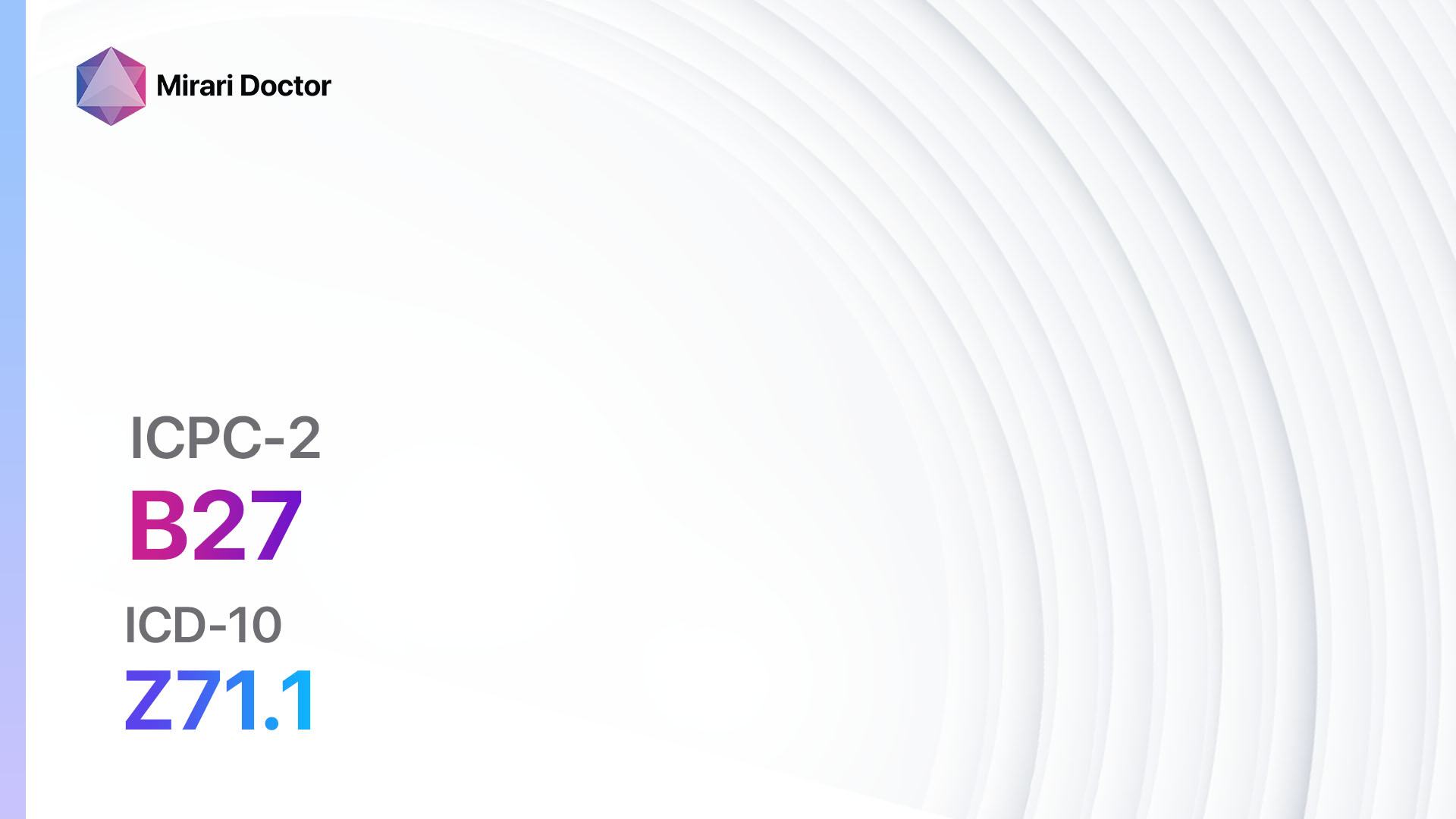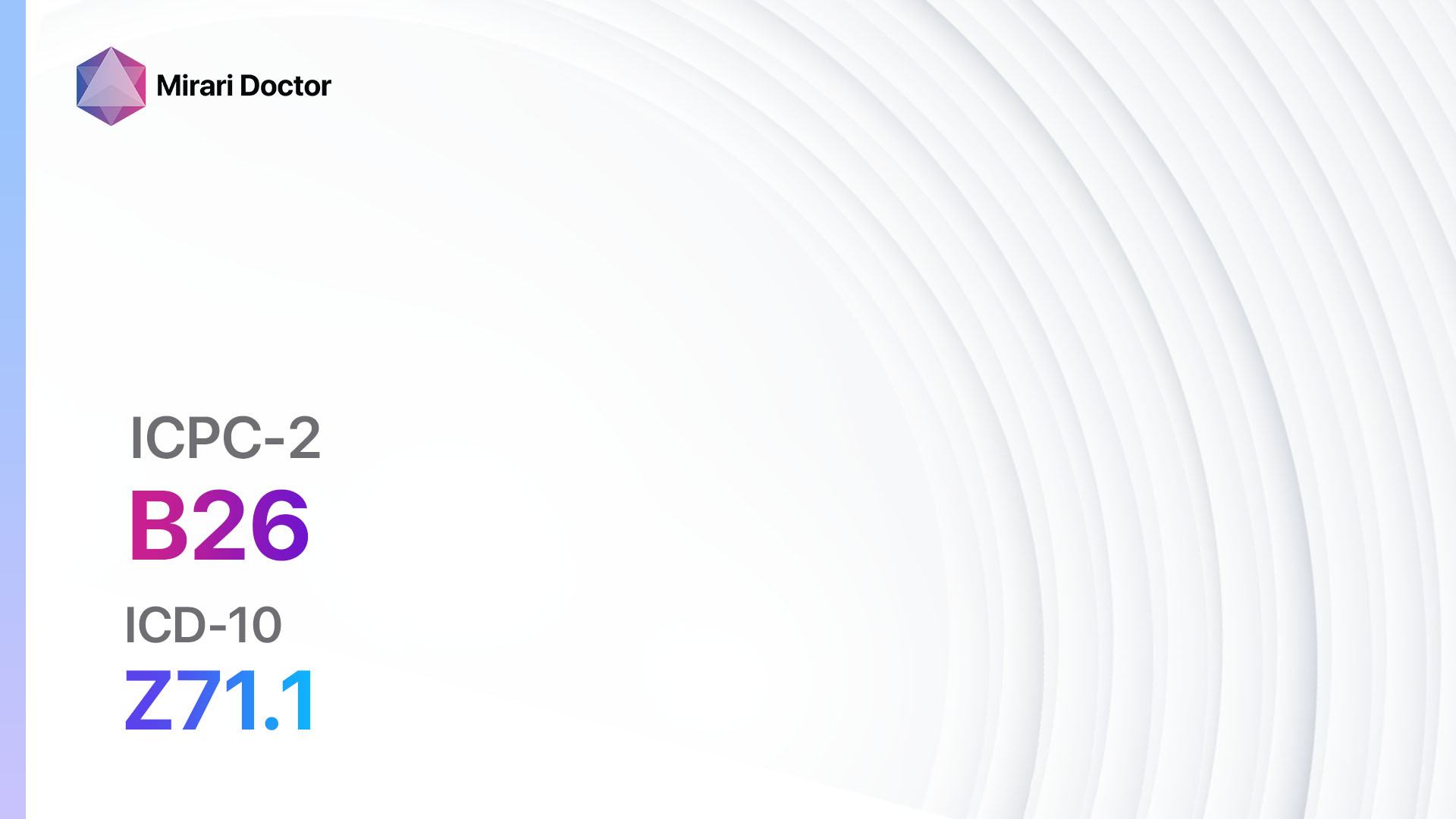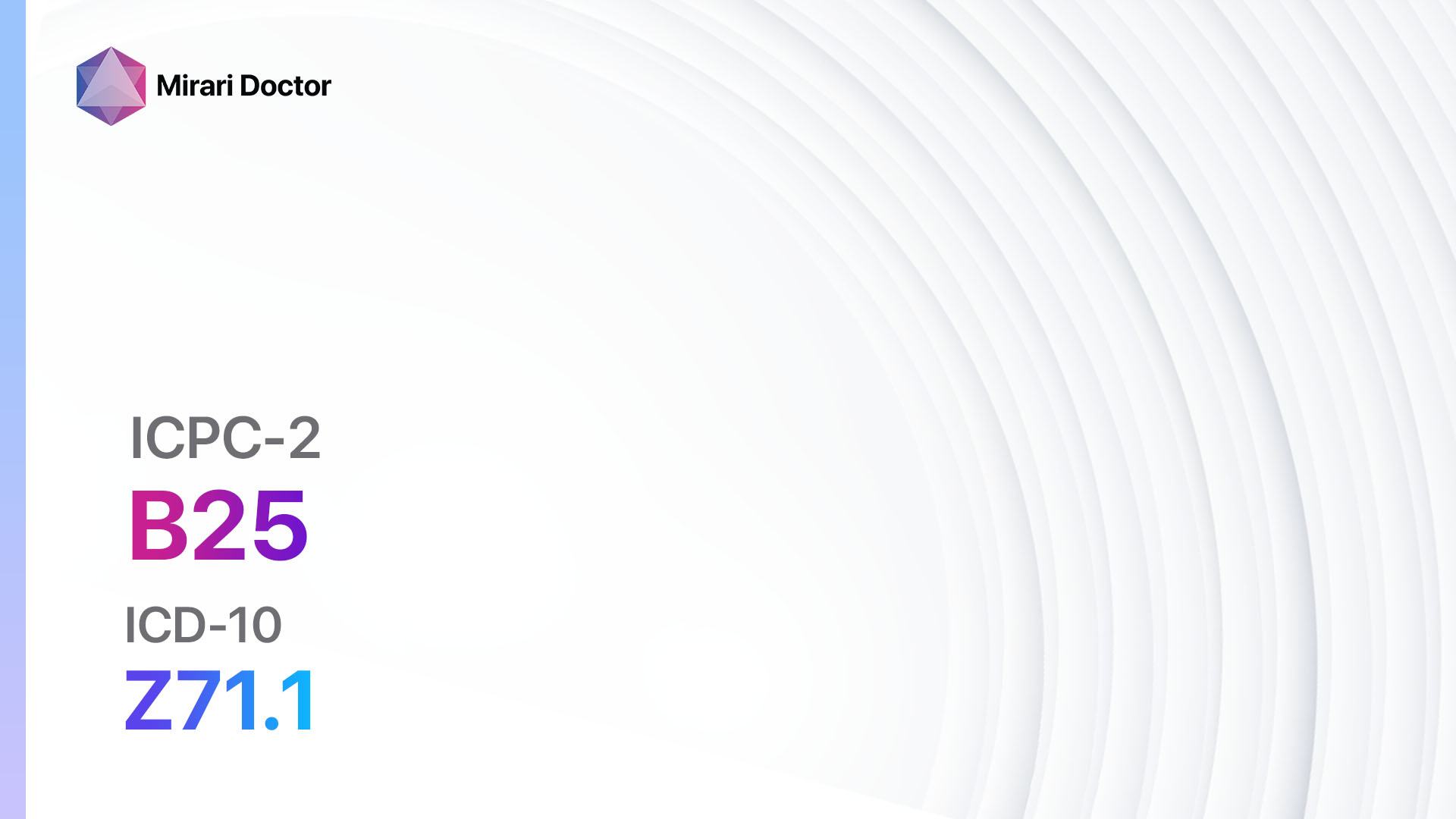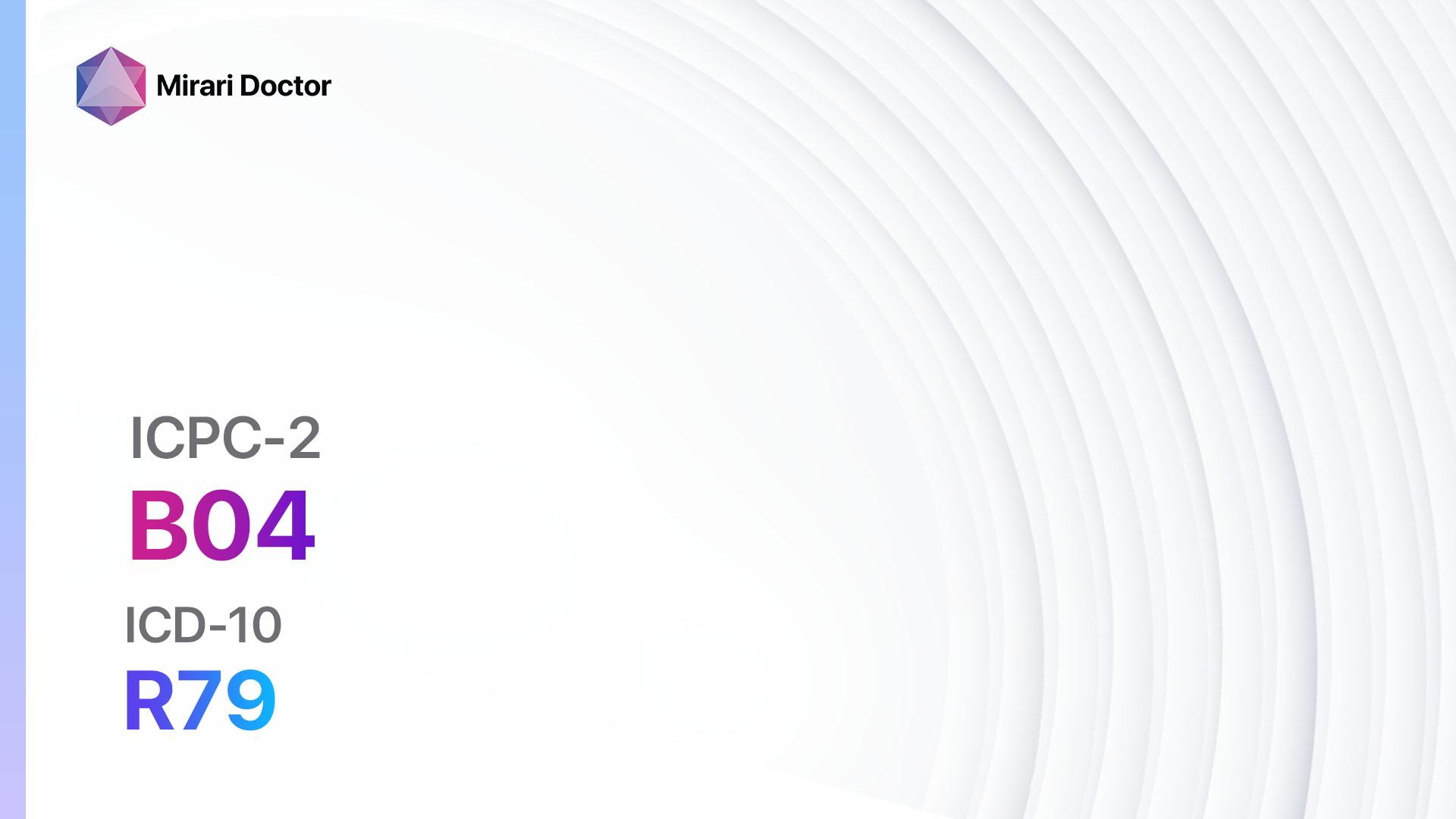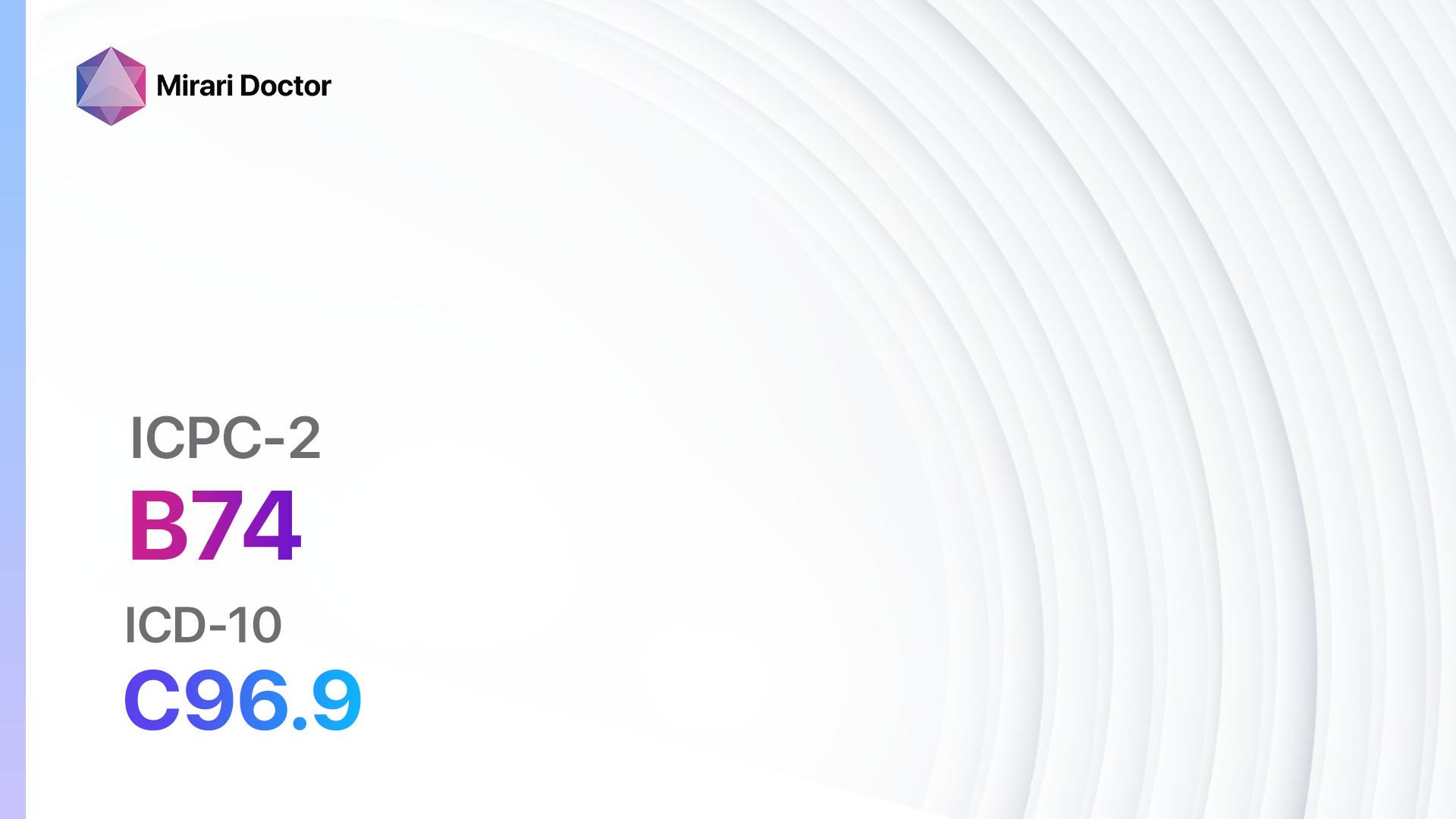
Introduction
Malignant neoplasm of blood other than leukemia or lymphoma is a rare type of cancer that affects the blood cells. It is characterized by the uncontrolled growth of abnormal blood cells in the bone marrow or lymphatic system[1][2]. This guide aims to provide an overview of the symptoms, causes, diagnostic steps, possible interventions, and lifestyle interventions for this condition.
Codes
- ICPC-2 Code: B74 Malignant neoplasm blood other
- ICD-10 Code: C96.9 Malignant neoplasm of lymphoid, haematopoietic and related tissue, unspecified
Symptoms
- Fatigue: Feeling tired and weak[3]
- Unexplained weight loss: Losing weight without trying[4]
- Frequent infections: Increased susceptibility to infections[5]
- Easy bruising or bleeding: Excessive bruising or prolonged bleeding[6]
- Enlarged lymph nodes: Swollen lymph nodes in the neck, armpits, or groin[7]
- Bone pain: Pain in the bones[8]
- Shortness of breath: Difficulty breathing[9]
- Night sweats: Excessive sweating during sleep[10]
Causes
The exact cause of malignant neoplasm of blood other than leukemia or lymphoma is unknown. However, certain risk factors may increase the likelihood of developing this condition:
- Genetic mutations: Inherited or acquired genetic mutations can lead to the development of abnormal blood cells.
- Exposure to radiation: Previous exposure to high levels of radiation, such as radiation therapy or nuclear accidents, may increase the risk.
- Chemical exposure: Exposure to certain chemicals, such as benzene, may increase the risk.
- Family history: Having a family history of blood disorders or certain genetic conditions may increase the risk.
Diagnostic Steps
Medical History
- Gather information about the patient’s symptoms, including the duration and severity.
- Identify any risk factors, such as exposure to radiation or chemicals.
- Assess the patient’s medical history, including any previous blood disorders or genetic conditions.
Physical Examination
- Perform a thorough physical examination, including a complete blood count (CBC) to assess the levels of different blood cells.
- Check for enlarged lymph nodes or an enlarged spleen.
- Assess the patient’s overall health and look for any signs of infection or other abnormalities.
Laboratory Tests
- Complete blood count (CBC): Measures the levels of red blood cells, white blood cells, and platelets in the blood.
- Blood chemistry tests: Assess the function of organs, such as the liver and kidneys.
- Bone marrow biopsy: Involves taking a sample of bone marrow to examine under a microscope for abnormal cells.
- Flow cytometry: Analyzes the characteristics of blood cells to identify abnormal cells.
- Cytogenetic analysis: Examines the chromosomes in blood cells for any genetic abnormalities.
Diagnostic Imaging
- X-rays: Can help detect any bone abnormalities or tumors.
- CT scan: Provides detailed images of the body to identify any tumors or enlarged lymph nodes.
- MRI: Uses magnetic fields and radio waves to create detailed images of the body, helping to detect tumors or abnormalities.
Other Tests
- Immunophenotyping: Identifies specific proteins on the surface of blood cells to determine their type and origin.
- Molecular testing: Looks for specific genetic mutations or changes in the DNA of blood cells.
- Lumbar puncture: Collects a sample of cerebrospinal fluid to check for the presence of abnormal cells in the central nervous system.
Follow-up and Patient Education
- Schedule regular follow-up appointments to monitor the patient’s condition and response to treatment.
- Provide education and support to the patient and their family regarding the disease, treatment options, and potential side effects.
- Encourage the patient to maintain a healthy lifestyle and adhere to the prescribed treatment plan.
Possible Interventions
Traditional Interventions
Medications:
Top 5 drugs for Malignant neoplasm blood other:
- Chemotherapy (e.g., Cyclophosphamide, Vincristine, Prednisone):
- Cost: Varies depending on the specific drugs and treatment regimen.
- Contraindications: Allergy to the medication, severe infections.
- Side effects: Nausea, hair loss, fatigue.
- Severe side effects: Bone marrow suppression, increased risk of infections.
- Drug interactions: Many potential drug interactions, consult with a healthcare provider.
- Warning: Regular blood tests required to monitor response and side effects.
- Targeted therapy (e.g., Imatinib, Dasatinib):
- Cost: Varies depending on the specific drugs and treatment regimen.
- Contraindications: Allergy to the medication, severe liver or kidney disease.
- Side effects: Nausea, diarrhea, rash.
- Severe side effects: Liver toxicity, heart problems.
- Drug interactions: Many potential drug interactions, consult with a healthcare provider.
- Warning: Regular blood tests required to monitor response and side effects.
- Immunotherapy (e.g., Rituximab):
- Cost: Varies depending on the specific drugs and treatment regimen.
- Contraindications: Allergy to the medication, severe infections.
- Side effects: Infusion reactions, fatigue, fever.
- Severe side effects: Severe allergic reactions, infections.
- Drug interactions: Many potential drug interactions, consult with a healthcare provider.
- Warning: Regular blood tests required to monitor response and side effects.
- Radiation therapy:
- Cost: Varies depending on the treatment regimen and duration.
- Contraindications: Pregnancy, severe bone marrow suppression.
- Side effects: Fatigue, skin changes, nausea.
- Severe side effects: Damage to surrounding tissues, secondary cancers.
- Drug interactions: N/A
- Warning: Regular follow-up appointments required to monitor response and side effects.
- Stem cell transplant:
- Cost: Varies depending on the type of transplant and hospital charges.
- Contraindications: Severe organ dysfunction, active infections.
- Side effects: Graft-versus-host disease, infections.
- Severe side effects: Organ failure, death.
- Drug interactions: N/A
- Warning: Requires a suitable donor and careful monitoring during and after the procedure.
Alternative Drugs:
- Interferon-alpha: Stimulates the immune system to fight cancer cells.
- Lenalidomide: An immunomodulatory drug that can help suppress the growth of cancer cells.
- Bortezomib: A proteasome inhibitor that can help kill cancer cells.
- Hydroxyurea: Inhibits the growth of cancer cells by interfering with their DNA synthesis.
- Arsenic trioxide: Induces apoptosis (cell death) in cancer cells.
Surgical Procedures:
- Stem cell transplant: Involves replacing the patient’s diseased bone marrow with healthy stem cells. Cost: Varies depending on the type of transplant and hospital charges.
- Splenectomy: Surgical removal of the spleen, which may be necessary in some cases. Cost: Varies depending on the hospital charges.
Alternative Interventions
- Acupuncture: May help alleviate symptoms and improve overall well-being. Cost: $60-$120 per session.
- Herbal supplements: Some herbal supplements, such as astragalus or mistletoe, may have potential benefits in supporting the immune system. Cost: Varies depending on the specific supplement.
- Mind-body techniques: Practices such as meditation, yoga, or tai chi may help reduce stress and improve quality of life. Cost: Varies depending on the specific practice.
- Nutritional therapy: Working with a registered dietitian to develop a personalized nutrition plan may help support overall health and well-being. Cost: Varies depending on the individual’s needs and consultations.
- Massage therapy: Can help reduce stress, improve circulation, and promote relaxation. Cost: $60-$120 per session.
Lifestyle Interventions
- Regular exercise: Engaging in regular physical activity can help improve overall health and well-being. Cost: Varies depending on individual preferences (e.g., gym membership, equipment).
- Healthy diet: Consuming a balanced diet rich in fruits, vegetables, whole grains, and lean proteins can support overall health. Cost: Varies depending on individual food choices and preferences.
- Stress management: Techniques such as deep breathing, meditation, or mindfulness can help reduce stress and improve overall well-being. Cost: Varies depending on the specific practice.
- Adequate sleep: Getting enough sleep is essential for overall health and well-being. Cost: Varies depending on individual sleep habits and preferences.
- Supportive care: Seeking emotional support from friends, family, or support groups can help cope with the challenges of the disease. Cost: Varies depending on individual preferences (e.g., therapy sessions, support group fees).
It is important to note that the cost ranges provided are approximate and may vary depending on the location and availability of the interventions. It is recommended to consult with healthcare professionals for personalized treatment options and cost estimates.
Mirari Cold Plasma Alternative Intervention
Understanding Mirari Cold Plasma
- Safe and Non-Invasive Treatment:Mirari Cold Plasma is a safe and non-invasive treatment option for various skin conditions. It does not require incisions, minimizing the risk of scarring, bleeding, or tissue damage.
- Efficient Extraction of Foreign Bodies:Mirari Cold Plasma facilitates the removal of foreign bodies from the skin by degrading and dissociating organic matter, allowing easier access and extraction.
- Pain Reduction and Comfort:Mirari Cold Plasma has a local analgesic effect, providing pain relief during the treatment, making it more comfortable for the patient.
- Reduced Risk of Infection:Mirari Cold Plasma has antimicrobial properties, effectively killing bacteria and reducing the risk of infection.
- Accelerated Healing and Minimal Scarring: Mirari Cold Plasma stimulates wound healing and tissue regeneration, reducing healing time and minimizing the formation of scars.
Mirari Cold Plasma Prescription
Video instructions for using Mirari Cold Plasma Device – B74 Malignant neoplasm blood other (ICD-10:C96.9)
| Mild | Moderate | Severe |
| Mode setting: 1 (Infection) Location: 1 (Sacrum) Morning: 15 minutes, Evening: 15 minutes | Mode setting: 1 (Infection) Location: 1 (Sacrum) Morning: 30 minutes, Lunch: 30 minutes, Evening: 30 minutes | Mode setting: 1 (Infection) Location: 1 (Sacrum) Morning: 30 minutes, Lunch: 30 minutes, Evening: 30 minutes |
| Mode setting: 2 (Wound Healing) Location: 1 (Sacrum) Morning: 15 minutes, Evening: 15 minutes | Mode setting: 2 (Wound Healing) Location: 1 (Sacrum) Morning: 30 minutes, Lunch: 30 minutes, Evening: 30 minutes | Mode setting: 2 (Wound Healing) Location: 1 (Sacrum) Morning: 30 minutes, Lunch: 30 minutes, Evening: 30 minutes |
| Mode setting: 3 (Antiviral Therapy) Location: 1 (Sacrum) Morning: 15 minutes, Evening: 15 minutes | Mode setting: 3 (Antiviral Therapy) Location: 1 (Sacrum) Morning: 30 minutes, Lunch: 30 minutes, Evening: 30 minutes | Mode setting: 3 (Antiviral Therapy) Location: 1 (Sacrum) Morning: 30 minutes, Lunch: 30 minutes, Evening: 30 minutes |
| Mode setting: 7 (Immunotherapy) Location: 1 (Sacrum) Morning: 15 minutes, Evening: 15 minutes | Mode setting: 7 (Immunotherapy) Location: 1 (Sacrum) Morning: 30 minutes, Lunch: 30 minutes, Evening: 30 minutes | Mode setting: 7 (Immunotherapy) Location: 1 (Sacrum) Morning: 30 minutes, Lunch: 30 minutes, Evening: 30 minutes |
| Total Morning: 60 minutes approx. $10 USD, Evening: 60 minutes approx. $10 USD | Total Morning: 120 minutes approx. $20 USD, Lunch: 120 minutes approx. $20 USD, Evening: 120 minutes approx. $20 USD, | Total Morning: 120 minutes approx. $20 USD, Lunch: 120 minutes approx. $20 USD, Evening: 120 minutes approx. $20 USD, |
| Usual treatment for 7-60 days approx. $140 USD – $1200 USD | Usual treatment for 6-8 weeks approx. $2,520USD – $3,360 USD | Usual treatment for 3-6 months approx. $5,400 USD – $10,800 USD |
 |
|
Use the Mirari Cold Plasma device to treat Malignant neoplasm blood other effectively.
WARNING: MIRARI COLD PLASMA IS DESIGNED FOR THE HUMAN BODY WITHOUT ANY ARTIFICIAL OR THIRD PARTY PRODUCTS. USE OF OTHER PRODUCTS IN COMBINATION WITH MIRARI COLD PLASMA MAY CAUSE UNPREDICTABLE EFFECTS, HARM OR INJURY. PLEASE CONSULT A MEDICAL PROFESSIONAL BEFORE COMBINING ANY OTHER PRODUCTS WITH USE OF MIRARI.
Step 1: Cleanse the Skin
- Start by cleaning the affected area of the skin with a gentle cleanser or mild soap and water. Gently pat the area dry with a clean towel.
Step 2: Prepare the Mirari Cold Plasma device
- Ensure that the Mirari Cold Plasma device is fully charged or has fresh batteries as per the manufacturer’s instructions. Make sure the device is clean and in good working condition.
- Switch on the Mirari device using the power button or by following the specific instructions provided with the device.
- Some Mirari devices may have adjustable settings for intensity or treatment duration. Follow the manufacturer’s instructions to select the appropriate settings based on your needs and the recommended guidelines.
Step 3: Apply the Device
- Place the Mirari device in direct contact with the affected area of the skin. Gently glide or hold the device over the skin surface, ensuring even coverage of the area experiencing.
- Slowly move the Mirari device in a circular motion or follow a specific pattern as indicated in the user manual. This helps ensure thorough treatment coverage.
Step 4: Monitor and Assess:
- Keep track of your progress and evaluate the effectiveness of the Mirari device in managing your Malignant neoplasm blood other. If you have any concerns or notice any adverse reactions, consult with your health care professional.
Note
This guide is for informational purposes only and should not replace the advice of a medical professional. Always consult with your healthcare provider or a qualified medical professional for personal advice, diagnosis, or treatment. Do not solely rely on the information presented here for decisions about your health. Use of this information is at your own risk. The authors of this guide, nor any associated entities or platforms, are not responsible for any potential adverse effects or outcomes based on the content.
Mirari Cold Plasma System Disclaimer
- Purpose: The Mirari Cold Plasma System is a Class 2 medical device designed for use by trained healthcare professionals. It is registered for use in Thailand and Vietnam. It is not intended for use outside of these locations.
- Informational Use: The content and information provided with the device are for educational and informational purposes only. They are not a substitute for professional medical advice or care.
- Variable Outcomes: While the device is approved for specific uses, individual outcomes can differ. We do not assert or guarantee specific medical outcomes.
- Consultation: Prior to utilizing the device or making decisions based on its content, it is essential to consult with a Certified Mirari Tele-Therapist and your medical healthcare provider regarding specific protocols.
- Liability: By using this device, users are acknowledging and accepting all potential risks. Neither the manufacturer nor the distributor will be held accountable for any adverse reactions, injuries, or damages stemming from its use.
- Geographical Availability: This device has received approval for designated purposes by the Thai and Vietnam FDA. As of now, outside of Thailand and Vietnam, the Mirari Cold Plasma System is not available for purchase or use.
References
- Swerdlow, S. H., Campo, E., Harris, N. L., Jaffe, E. S., Pileri, S. A., Stein, H., … & Vardiman, J. W. (Eds.). (2017). WHO classification of tumours of haematopoietic and lymphoid tissues (revised 4th edition). International Agency for Research on Cancer.
- Arber, D. A., Orazi, A., Hasserjian, R., Thiele, J., Borowitz, M. J., Le Beau, M. M., … & Vardiman, J. W. (2016). The 2016 revision to the World Health Organization classification of myeloid neoplasms and acute leukemia. Blood, 127(20), 2391-2405.
- Ferrara, F., & Schiffer, C. A. (2013). Acute myeloid leukaemia in adults. The Lancet, 381(9865), 484-495.
- Tefferi, A., & Vardiman, J. W. (2008). Classification and diagnosis of myeloproliferative neoplasms: the 2008 World Health Organization criteria and point-of-care diagnostic algorithms. Leukemia, 22(1), 14-22.
- Estey, E., & Döhner, H. (2006). Acute myeloid leukaemia. The Lancet, 368(9550), 1894-1907.
- Germing, U., Kobbe, G., Haas, R., & Gattermann, N. (2013). Myelodysplastic syndromes: diagnosis, prognosis, and treatment. Deutsches Ärzteblatt International, 110(46), 783.
- Küppers, R., Engert, A., & Hansmann, M. L. (2012). Hodgkin lymphoma. The Journal of clinical investigation, 122(10), 3439-3447.
- Kyle, R. A., & Rajkumar, S. V. (2008). Multiple myeloma. Blood, The Journal of the American Society of Hematology, 111(6), 2962-2972.
- Hallek, M., Cheson, B. D., Catovsky, D., Caligaris-Cappio, F., Dighiero, G., Döhner, H., … & Kipps, T. J. (2018). iwCLL guidelines for diagnosis, indications for treatment, response assessment, and supportive management of CLL. Blood, 131(25), 2745-2760.
- Swerdlow, S. H. (2008). WHO classification of tumours of haematopoietic and lymphoid tissues. WHO classification of tumours, 22008(2), 439.
Related articles
Made in USA


